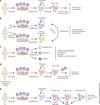Patient-derived induced pluripotent stem cells in cancer research and precision oncology
- PMID: 27923030
- PMCID: PMC5233709
- DOI: 10.1038/nm.4238
Patient-derived induced pluripotent stem cells in cancer research and precision oncology
Erratum in
-
Author Correction: Patient-derived induced pluripotent stem cells in cancer research and precision oncology.Nat Med. 2019 May;25(5):861. doi: 10.1038/s41591-019-0435-1. Nat Med. 2019. PMID: 30944418
Abstract
Together with recent advances in the processing and culture of human tissue, bioengineering, xenotransplantation and genome editing, Induced pluripotent stem cells (iPSCs) present a range of new opportunities for the study of human cancer. Here we discuss the main advantages and limitations of iPSC modeling, and how the method intersects with other patient-derived models of cancer, such as organoids, organs-on-chips and patient-derived xenografts (PDXs). We highlight the opportunities that iPSC models can provide beyond those offered by existing systems and animal models and present current challenges and crucial areas for future improvements toward wider adoption of this technology.
Figures



References
-
- Takahashi K, Yamanaka S. Induction of pluripotent stem cells from mouse embryonic and adult fibroblast cultures by defined factors. Cell. 2006;126:663–676. - PubMed
-
- Takahashi K, et al. Induction of pluripotent stem cells from adult human fibroblasts by defined factors. Cell. 2007;131:861–872. - PubMed
-
- Zeltner N, Studer L. Pluripotent stem cell-based disease modeling: current hurdles and future promise. Curr. Opin. Cell Biol. 2015;37:102–110. - PubMed
MeSH terms
Grants and funding
LinkOut - more resources
Full Text Sources
Other Literature Sources
Medical

